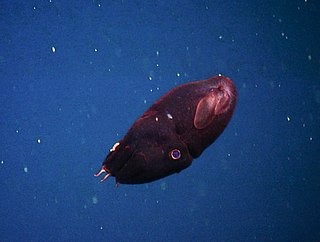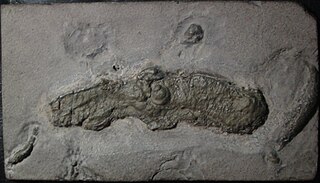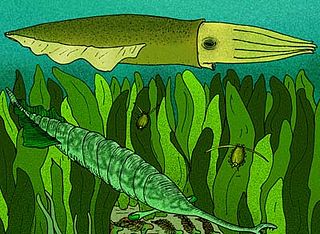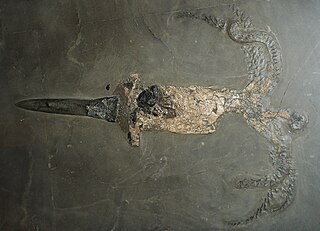
An octopus is a soft-bodied, eight-limbed mollusc of the order Octopoda. The order consists of some 300 species and is grouped within the class Cephalopoda with squids, cuttlefish, and nautiloids. Like other cephalopods, an octopus is bilaterally symmetric with two eyes and a beaked mouth at the center point of the eight limbs. The soft body can radically alter its shape, enabling octopuses to squeeze through small gaps. They trail their eight appendages behind them as they swim. The siphon is used both for respiration and for locomotion, by expelling a jet of water. Octopuses have a complex nervous system and excellent sight, and are among the most intelligent and behaviourally diverse of all invertebrates.

A squid is a mollusc with an elongated soft body, large eyes, eight arms, and two tentacles in the superorder Decapodiformes, though many other molluscs within the broader Neocoleoidea are also called squid despite not strictly fitting these criteria. Like all other cephalopods, squid have a distinct head, bilateral symmetry, and a mantle. They are mainly soft-bodied, like octopuses, but have a small internal skeleton in the form of a rod-like gladius or pen, made of chitin.

A cephalopod is any member of the molluscan class Cephalopoda such as a squid, octopus, cuttlefish, or nautilus. These exclusively marine animals are characterized by bilateral body symmetry, a prominent head, and a set of arms or tentacles modified from the primitive molluscan foot. Fishers sometimes call cephalopods "inkfish", referring to their common ability to squirt ink. The study of cephalopods is a branch of malacology known as teuthology.

Nectocaris is a genus of squid-like animal of controversial affinities known from the Cambrian period. The initial fossils were described from the Burgess Shale of Canada. Other similar remains possibly referrable to the genus are known from the Emu Bay Shale of Australia and Chengjiang Biota of China.

The vampire squid is a small cephalopod found throughout temperate and tropical oceans in extreme deep sea conditions. The vampire squid uses its bioluminescent organs and its unique oxygen metabolism to thrive in the parts of the ocean with the lowest concentrations of oxygen. It has two long retractile filaments, located between the first two pairs of arms on its dorsal side, which distinguish it from both octopuses and squids, and places it in its own order, Vampyromorphida, although its closest relatives are octopods. As a phylogenetic relict, it is the only known surviving member of its order.

Vampyroteuthidae is a family of vampyromorph cephalopods containing the extant vampire squid, Vampyroteuthis infernalis, and the extinct genera Necroteuthis, Provampyroteuthis, and Vampyronassa.

Coleoidea or Dibranchiata, is one of the two subclasses of cephalopods, containing all the various taxa popularly thought of as "soft-bodied" or "shell-less". Unlike its extant sister group Nautiloidea, whose members have a rigid outer shell for protection, the coleoids have at most an internal shell called cuttlebone or gladius that is used for buoyancy or as muscle anchorage. Some species, notably incirrate octopuses, have lost their cuttlebone altogether, while in some it has been replaced by a chitinous support structure. A unique trait of the group is the ability to edit their own RNA.

Octopodiformes is a superorder of the subclass Coleoidea, comprising the octopuses and the vampire squid. All living members of Octopodiformes have eight arms, either lacking the two tentacles of squid or modifying the tentacles into thin filaments. Octopodiformes is often considered the crown group of octopuses and vampire squids, including all descendants of their common ancestor. Some authors use the term Vampyropoda for the same general category, though others use "Vampyropoda" to refer to the total group. Another term is Octobranchia, referring to cephalopods without prominent tentacles.
Pohlsepia mazonensis is a species of fossil organism with unknown affinity. Although it was originally identified as an extinct cephalopod, later studies denied that interpretation. The species is known from a single exceptionally preserved fossil discovered in the late Carboniferous (Pennsylvanian) Francis Creek Shale of the Carbondale Formation, north-east Illinois, United States.

Proteroctopus is an extinct genus of cephalopod that lived in the Middle Jurassic, approximately 164 million years ago. It is only known from a single species P. ribeti. The single fossil specimen assigned to this species originates from the Lower Callovian of Voulte-sur-Rhône in France. It is currently on display at the Musée de Paléontologie de La Voulte-sur-Rhône. While originally interpreted as an early octopus, a 2016 restudy of the specimen considered it to be a basal member of the Vampyropoda, less closely related to octopus or vampire squid than either of the two groups are to each other. A phylogenetic analysis by Kruta et. al indicates that Proteroctopus may be more closely related to the Vampyromorpha based on its unique morphology: two fins, head fused to the body, eight arms, two rows of oblique sucker, a gladius and absence of an ink sac. A 2022 phylogenetic analysis also found it to be more closely related to vampire squid than to octopuses.

Kerygmachela kierkegaardi is a kerygmachelid gilled lobopodian from the Cambrian Stage 3 aged Sirius Passet Lagerstätte in northern Greenland. Its anatomy strongly suggests that it, along with its relative Pambdelurion whittingtoni, was a close relative of radiodont (anomalocaridids) and euarthropods. The generic name "Kerygmachela" derives from the Greek words Kerygma (proclamation) and Chela (claw), in reference to the flamboyant frontal appendages. The specific name, "kierkegaardi" honors Danish philosopher Søren Kierkegaard.

Vampyronassa rhodanica is an extinct vampyromorph cephalopod known from around 20 fossils from the Lower Callovian of La Voulte-sur-Rhône, Ardèche, France.

All cephalopods possess flexible limbs extending from their heads and surrounding their beaks. These appendages, which function as muscular hydrostats, have been variously termed arms, legs or tentacles.

Jeletzkya douglassae is a fossil coleoid from the early Pennsylvanian Mazon Creek lagerstätten and represents the earliest known crown-group squid. Non-mineralized anatomy is preserved and comprises ten hooked tentacles and a radula. It is too poorly understood for assignment to any particular cephalopod taxon.
The cephalopods have a long geological history, with the first nautiloids found in late Cambrian strata, and purported stem-group representatives present in the earliest Cambrian lagerstätten.

Belemnitida is an extinct order of squid-like cephalopods that existed from the Late Triassic to Late Cretaceous. Unlike squid, belemnites had an internal skeleton that made up the cone. The parts are, from the arms-most to the tip: the tongue-shaped pro-ostracum, the conical phragmocone, and the pointy guard. The calcitic guard is the most common belemnite remain. Belemnites, in life, are thought to have had 10 hooked arms and a pair of fins on the guard. The chitinous hooks were usually no bigger than 5 mm (0.20 in), though a belemnite could have had between 100 and 800 hooks in total, using them to stab and hold onto prey.
RacCS203 is a bat-derived strain of severe acute respiratory syndrome–related coronavirus collected in acuminate horseshoe bats from sites in Thailand and sequenced by Lin-Fa Wang's team. It has 91.5% sequence similarity to SARS-CoV-2 and is most related to the RmYN02 strain. Its spike protein is closely related to RmYN02's spike, both highly divergent from SARS-CoV-2's spike.
This list of fossil molluscs described in 2022 is a list of new taxa of fossil molluscs that were described during the year 2022, as well as other significant discoveries and events related to molluscan paleontology that occurred in 2022.
This list of fossil molluscs described in 2023 is a list of new taxa of fossil molluscs that were described during the year 2023, as well as other significant discoveries and events related to molluscan paleontology that occurred in 2023.













